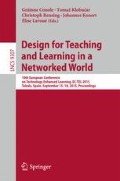Abstract
Training children safe behavior in traffic situations is both important and challenging. One of the problems is children’s limited perceptual-motor abilities and associated difficulties with important cognitive skills required to be safe pedestrians. Existing traffic education programs focus more on theoretical knowledge, while training practical skills in the real world is dangerous, expensive and hard to organize. This paper presents a promising alternative – an intelligent virtual reality training environment that allows children to practice their pedestrian skills. It describes the interface and architecture of the system, as well as the skill model of the pedestrian safety domain. The results of the conducted pilot study show that children of the target age group rarely have problems with applying (and acquiring) “basic” pedestrian skills in the developed virtual environment. However, when applying and learning “advanced” skills, they require additional support.
References
Whitebread, D., Neilson, K.: The contribution of visual search strategies to the development of pedestrian skills by 4-11 year-old children. Br. J. Educ. Psychol. 70(4), 539–557 (2000)
Federal Statistical Office of Germany: Child pedestrian injury in traffic 2013. https://www.destatis.de/DE/Publikationen/Thematisch/TransportVerkehr/Verkehrsunfaelle/UnfaelleKinder5462405137004.pdf
National Highway Traffic Safety Administration: Traffic safety facts: 2011 data. http://www-nrd.nhtsa.dot.gov/Pubs/811767.pdf
Toroyan, T., Peden, M. (eds.): Youth and road safety. WHO, Geneva (2007)
Oron-Gilad, T., Meir, A., Tapiro, H., Borowsky, A.: Towards understanding child-pedestrian’s deficits in perceiving hazards when crossing the road. Final Report (2011)
Schwebel, D.C., Davis, A.L., O’Neal, E.E: Child pedestrian injury: a review of behavioral risks and preventive strategies. Am. J. Lifestyle Med. 6(4), 292–302 (2012)
McComas, J., MacKay, M., Pivik, J.: Effectiveness of virtual reality for teaching pedestrian safety. CyberPsychology Behav. 5(3), 185–190 (2002)
Thomson, J.A., Tolmie, A.K., Foot, H.C., Whelan, K.M., Sarvary, P., Morrison, S.: Influence of virtual reality training on the roadside crossing judgments of child pedestrians. J. Exp. Psychol. Appl. 11, 175–186 (2005)
Congiu, M., Whelan, M., Oxley, J., Charlton, J., D’Elia, A., Muir, C.: Child Pedestrian: Factors Associated with Ability to Cross Roads Safely and Development of Training Package. Monash University Accident Research Centre, Victoria (2008)
Schwebel, D.C., Gaines, J., Severson, J.: Validation of virtual reality as a tool to understand and prevent child pedestrian injury. Accid. Anal. Prev. 40(4), 1394–1400 (2008)
Schwebel, D.C., McClure, L.A., Severson, J.: Usability and feasibility of an internet-based virtual pedestrian environment to teach children to cross streets safely. Virtual Reality 18(1), 5–11 (2014)
Lane, H.C., Johnson, W.L.: Intelligent tutoring and pedagogical experience manipulation in virtual learning environments. In: The PSI Handbook of Virtual Environments for Training and Education, vol. 3 (2008)
Johnson, W.L., Rickel, J.: Steve: an animated pedagogical agent for procedural training in virtual environments. ACM SIGART Bull. 8(1–4), 16–21 (1997)
Amokrane, K., Lourdeaux, D., Burkhardt, J.M.: HERA: learner tracking in a virtual environment. Int. J. Virtual Reality 7(3), 23–30 (2008)
Buche, C., Bossard, C., Querrec, R., Chevaillier, P.: PEGASE: a generic and adaptable intelligent system for virtual reality learning environments. Int. J. Virtual Reality 9(2), 73–85 (2010)
Van der Molen, H.H., Rothengatter, J.A., Vinjé, M.P.: Blueprint of an analysis of the pedestrian’s task I. Accid. Anal. Prev. 13(3), 175–191 (1981)
Thomson, J.A., Tolmie, A., Foot, H.C., McLaren, B.: Child development and the aims of road safety education. Road Safety Research Report No. 1. HMSO, London (1996)
Ampofo-Boateng, K., Thomson, J.A.: Children’s perception of safety and danger on the road. Br. J. Psychol. 82, 487–505 (1991)
Hill, R., Lewis, V., Dunbar, G.: Young children’s concepts of danger. Br. J. Dev. Psychol. 18, 103–120 (2000)
Underwood, J., Dillon, G., Farnsworth, B., Twiner, A.: Reading the road: the influence of age and sex on child pedestrians’ perceptions of road risk. Br. J. Psychol. 98, 93–110 (2007)
Orlosky, J., Weber, M., Gu, Y., Sonntag, D., Sosnovsky, S.: An interactive pedestrian environment simulator for cognitive monitoring and evaluation. In: 20th International Conference on Intelligent User Interfaces, pp. 57–60 (2015)
Corbett, A.T., Koedinger, K.R., Anderson, J.R.: Chapter 37 intelligent tutoring systems. In: Handbook of Human-Computer Interaction. Elsevier Science B.V., Amsterdam (1997)
Millington, I., Funge, J.: Behavior trees. In: Artificial Intelligence for Games, 2nd edn, pp. 334–370. Morgan Kaufmann Publishers Inc., San Francisco (2009)
David, K.S., Sullivan, M.: Expectations for walking speeds: standards for students in elementary schools. Pediatric Phys. Therapy 17(2), 120–127 (2005)
Piaget, J.: The Origins of Intelligence in Children. International Universities Press, New York (1952)
Gu, Y., Sosnovsky, S.: Recognition of student intentions in a virtual reality training environment. In: 19th International Conference on Intelligent User Interfaces, pp. 69–72 (2014)
Acknowledgements
This research was conducted within SafeChild project funded by BMBF (grant 01IS12050) under the Software Campus program.
Author information
Authors and Affiliations
Corresponding author
Editor information
Editors and Affiliations
Rights and permissions
Copyright information
© 2015 Springer International Publishing Switzerland
About this paper
Cite this paper
Gu, Y., Sosnovsky, S., Ullrich, C. (2015). SafeChild: An Intelligent Virtual Reality Environment for Training Pedestrian Safety Skills. In: Conole, G., Klobučar, T., Rensing, C., Konert, J., Lavoué, E. (eds) Design for Teaching and Learning in a Networked World. EC-TEL 2015. Lecture Notes in Computer Science(), vol 9307. Springer, Cham. https://doi.org/10.1007/978-3-319-24258-3_11
Download citation
DOI: https://doi.org/10.1007/978-3-319-24258-3_11
Published:
Publisher Name: Springer, Cham
Print ISBN: 978-3-319-24257-6
Online ISBN: 978-3-319-24258-3
eBook Packages: Computer ScienceComputer Science (R0)

